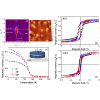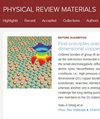具有垂直磁各向异性的 SrRuO3 磁性隧道结中对称驱动的大隧道磁阻
IF 3.4
3区 材料科学
Q2 MATERIALS SCIENCE, MULTIDISCIPLINARY
引用次数: 0
摘要
由外延生长的复杂氧化物组成的磁隧道结(MTJ)为控制隧道态的对称性和定制实际应用中有用的磁各向异性提供了一个多功能平台。这项研究利用沉积在两个铁磁性 SrRuO3 电极之间的 SrTiO3 薄膜作为绝缘栅,形成完全外延的 MTJ,并展示了这些功能。传输测量结果表明隧穿磁阻(TMR)很大,大大超过了以前在基于 SrRuO3 电极的 MTJ 中发现的 TMR 值。这些结果的原因是 SrRuO3 的垂直磁各向异性以及 SrTiO3/SrRuO3 (001) 界面的对称性和自旋之间的匹配(不匹配),以实现 MTJ 磁化状态的平行(反平行),并得到密度泛函(DFT)计算的支持。TMR 的角度变化表明,SrRuO3 电极包含多个磁畴,从而使器件能够呈现至少三种稳定的电阻状态。本文章由计算机程序翻译,如有差异,请以英文原文为准。

Symmetry-driven large tunneling magnetoresistance in SrRuO3 magnetic tunnel junctions with perpendicular magnetic anisotropy
Magnetic tunnel junctions (MTJs) that are comprised of epitaxially grown complex oxides offer a versatile platform to control the symmetry of tunneling states and tailor magnetic anisotropy useful for practical applications. This work employs thin films of as an insulating barrier deposited between two ferromagnetic electrodes to form fully epitaxial MTJs and demonstrate these functionalities. Transport measurements demonstrate large tunneling magnetoresistance (TMR), significantly exceeding previously found values of TMR in MTJs based on electrodes. These results are explained by perpendicular magnetic anisotropy of and matching (mismatching) between symmetry and spin across the (001) interface for the parallel (antiparallel) MTJ magnetization state, supported by density functional (DFT) calculations. The angular variation of TMR indicates that the electrodes contain multiple magnetic domains, allowing the devices to exhibit at least three stable resistance states.
求助全文
通过发布文献求助,成功后即可免费获取论文全文。
去求助
来源期刊

Physical Review Materials
Physics and Astronomy-Physics and Astronomy (miscellaneous)
CiteScore
5.80
自引率
5.90%
发文量
611
期刊介绍:
Physical Review Materials is a new broad-scope international journal for the multidisciplinary community engaged in research on materials. It is intended to fill a gap in the family of existing Physical Review journals that publish materials research. This field has grown rapidly in recent years and is increasingly being carried out in a way that transcends conventional subject boundaries. The journal was created to provide a common publication and reference source to the expanding community of physicists, materials scientists, chemists, engineers, and researchers in related disciplines that carry out high-quality original research in materials. It will share the same commitment to the high quality expected of all APS publications.
 求助内容:
求助内容: 应助结果提醒方式:
应助结果提醒方式:


